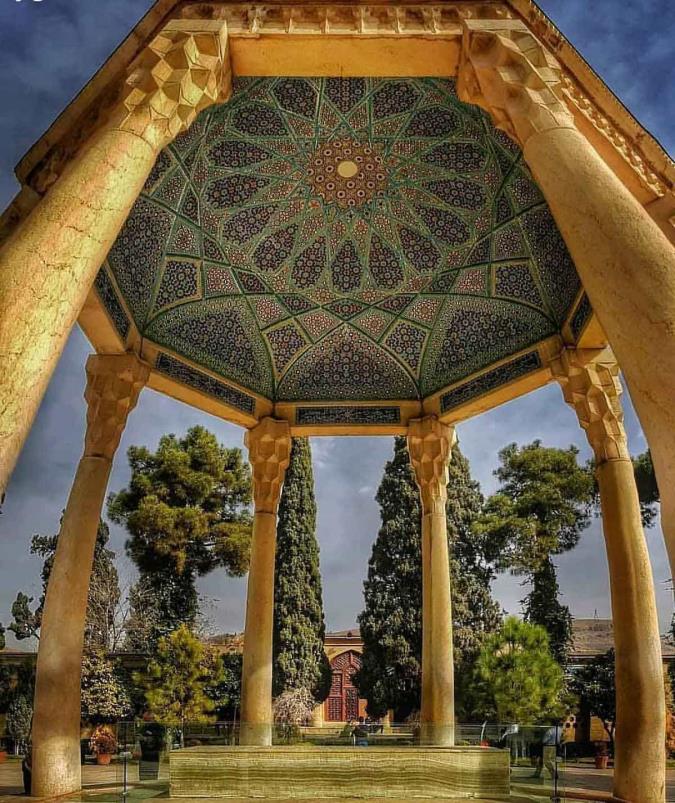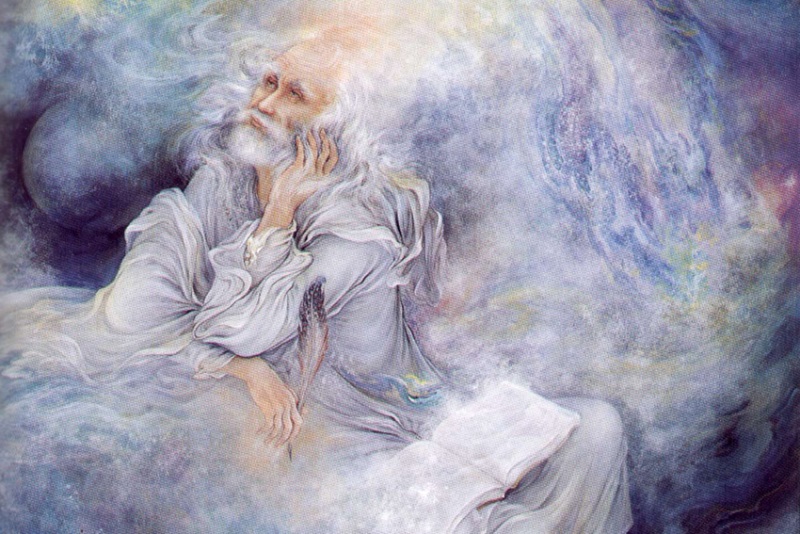Introduction to Hafiz
If we want to name a city that is the cradle of Persian art and literature, it would be undoubtedly Shiraz. A city with a rich history, pleasant climate, unique architecture, and everything needed to nurture the soul, to cultivate such greatness. Shiraz is not only the cradle of the great Persian literature masters but also the soil has embraced many of those loved ones’ bodies. One of the greats who rested in the city is Khawje Shams-od-Din Moḥammad Ḥafeẓ-e Shirazi, known as Lasan al-Ghayb (the Tongue of the Unseen Realms), the great poet of the 14th century. Hafiz memorized the Qur’an and composed poems that narrated a message from God from an unseen world, so he was given such a title. Hafez was one of the most famous speakers in the world, died in 729 AH. His tomb is in the northern part of Shiraz and south of the Qur’an Gate, inviting Hafiz’s lovers to Shiraz throughout the year.
Why Is He Called Hafez?
There is no exact trace of the Persian poet’s lifestyle, and despite the high reputation of this great poet, Hafez, there is little information about his family and his life, especially when he was born. Hafiz, as a child, was able to preserve the whole Quran by listening to the sound of reciting it, and that is why his name is Hafiz which means who memorize in Persian. Some call him Lasan al-Ghayb; a person who talks about facts that no one knows.
The Footprints of Love in Hafez Poems
During his adolescence, Hafez also wrote poems by great poets such as Saadi, Attar, Rumi, and Nezami. He has referred to several concepts of human life in his work, but one subject has always been present in his works; love constantly. The love story starts when Hafez fell in love with Jahan Malek Khatun, who ironically was also a poet. He names the mistress Shakheh Nabat in his poems. There is a legend that says when Hafiz could not marry the girl due to his poverty, he vowed to go to a tomb for 40 Friday nights and pray all night. On the fortieth night, Hafez fell asleep from austerity and saw Imam Ali (the first Shia Imam) in a dream telling him the doors of the unseen treasuries have been opened for him and took Hafez to the high authorities in mysticism and science. Imam Ali said to him that he will be the memorizer of the Quran. So when Hafiz woke up, he considered himself a poet, a mystic, and inadvertently recited a verse. Therefore, he is a literate human being, knowledgeable in the literary sciences, religious principles, and mysticism.
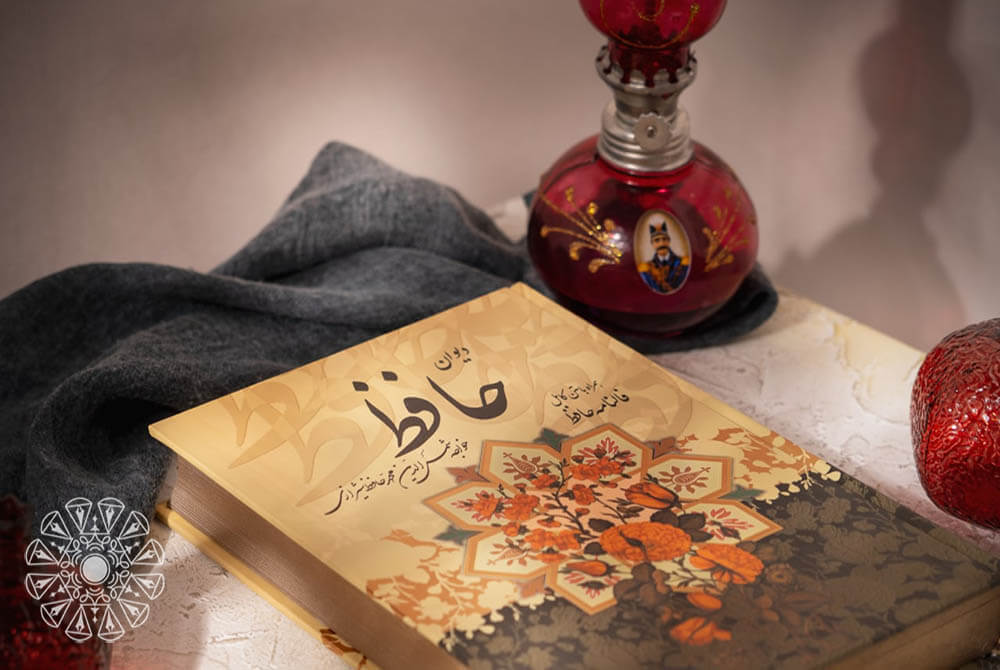
Hafez’s Role Models in Life and Poetry
Hafez was a literate person and a scholar aware of literary knowledge, and religious principles; his great and innate talent has allowed Hafez to think and imagine for a long time. Among the poets he was influenced by, we should mention Salman after Khwaju Kermani. The reason is that they all three lived in the same era. Hafez Shirazi welcomed other poets such as Saadi and Rumi, and The Divan of Hafez has become very popular with these influences. As well as one of the turning points in Hafiz’s life was his meeting with Attar of Nishapur; He mentioned Attar as his master and role model until the end of his life and in some poems.
Hafiz Poets
The most significant characteristic of the poetry of Hafez is the preservation of interpretation; So that whoever opens The Divan of Hafez and reads the sonnet will have a particular understanding of the poem, depending on their mood, as if Hafez had written that poem for just that moment! Hafiz Shirazi has since been praised throughout the Islamic world by contemporary poets from Baghdad to India and is today the most popular poet among Iranians and one of the world-famous poets. You can find his work in many countries such as Azerbaijan, Armenia, and Georgia.
Goethe and Emerson are some of the most famous people who praised Hafez, and both translated his poems into English, and Goethe believed that Hafez has no counterpart after a long look at Hafez’s poetry! Nietzsche and Arthur Conan Doyle (the Sherlock Holmes character’s creator), the great Western thinkers, praised Hafiz’s poems. In his writings, Nietzsche has repeatedly mentioned the name of Hafez beside Goethe, referring to both as the peaks of deep wisdom. Federico García Lorca and Johannes Brahms also praised Hafez, and some even said that Queen Victoria consulted with The Divan of Hafez on special occasions.
History of Hafiz Tomb
About 65 years after Hafez’s death, Shamsuddin Mohammad Yaghmaei, who was Gurkani’s master and minister’s ruler, built a dome over Hafiz’s tomb during the reign of Mirza Abolghasem Gurkani and designed a large pool in front of it, filled with Roknabad water. Different people throughout history have made many changes in the mausoleum’s structure to make it what it is today.
Hafez’s tomb was restored during the reign of Shah Abbas Safavid in the early 11th century AH and was rebuilt during the reign of Nader Shah Afshar. There were also many changes in the tomb during the rise of Zandieh’s rule. Karim Khan Zand constructed a new building on the previous structure in 1189 AH; the building embraced a hall with four one-piece stone columns in the style of Zandieh-era architecture, containing two entrances to the north and south.
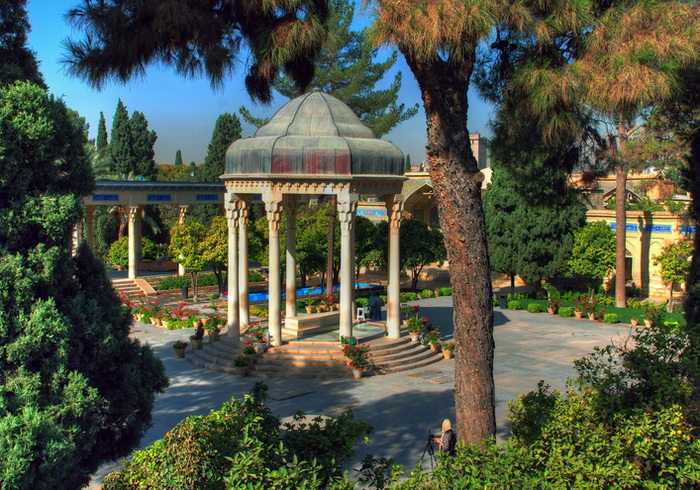
- Hafiz Mausoleum embraces all sense of love, juice and palmy verses engraved on his tomb stone to bloom soul and inspire thoughts in Shiraz.
Hafiz Tomb Garden
Additionally, the architect built the left and right sides of the two rooms in the form that the tomb to be in the hall’s north. There was a garden in the south of it, which added to the splendor and magnificence of the complex. The four columns of 5 meters height showcase themselves in the middle of the hall through their faded and unique patterns, in front of the stairs. Karim Khan ordered a marble stone carving for the tomb of Hafiz Shirazi. After the stone’s preparation, Haji Aghasi Beg Afshar engraved two lyric poems of Hafez, written in Nastaliq script. Hafez’s tomb was renovated again after the Islamic Revolution, and the tombs and gardens around the mausoleum were connected.
Architecture of Hafezieh
The tomb of Hafez is one meter above the ground, surrounded by five steps that allow people to enter the place. Above the court, there is a copper dome in the shape of a dervishes’ hat on eight columns that reach a height of 10 meters inside, and the building’s outside is decorated with seven-coloured mosaic tiles. It is interesting to know that the design of today’s tomb columns has roots in the column design of the Zandieh’s period.
The building’s total area is about 2 hectares, including four entrance doors: the south door, which is the main door of the complex, two large and small doors on the west side, and one door that opens to the greenhouse on the northeast side. The mausoleum contains north and south courtyards, separated by two rows of stone stairs. There are two gardens around the corridors with cypress and pine trees. On the east and west side are the courtyards of oranges, which in addition to giving freshness to the tomb’s atmosphere, are immersed in the blossom in the spring and make the memory space fragrant.
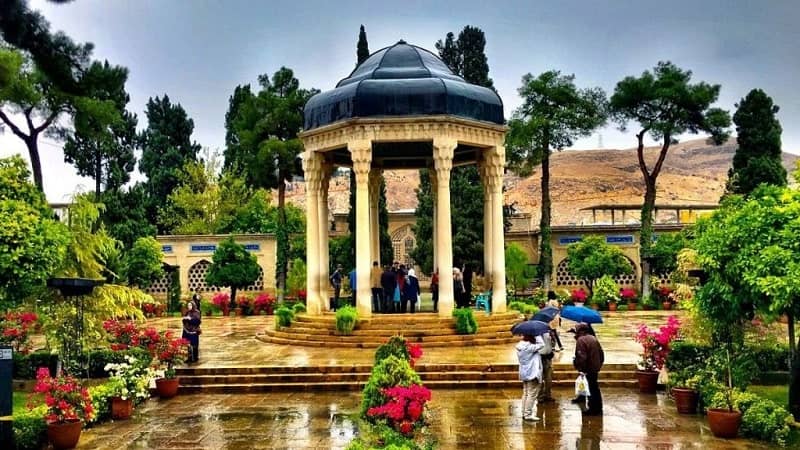
Symbols of Hafez Tomb
The tomb’s scheme makes you come across a different symbol with every step you take towards the complex. Let’s take a look at these symbols and the philosophy of each:
Symbol of Captivity in the Industrial and Modern World
Hafez Tomb is in one of the crowded streets of Shiraz, so it has disappeared and is not visible from the street. Therefore, the mausoleum displays the captivity of mystical thoughts and ideas in the industrial world.
Memory, A Symbol of the Material World
The southern side of the complex is considered a symbol of the material world, which reaches the divine ascension by ascending from its porch.
The Tomb’s Dome Is A Symbol of the Sky
The northern part of the tomb is the kingdom’s symbol. This section contains eight entrance and exit doors and a building with eight stone columns that have remained intact from the Mozaffarian period until today. The number eight is a symbol of the eighth century A.H in which Hafez lived, and the number can also be considered a symbol of the eight gates of heaven.
The domes’ exterior is a symbol of the sky. It is similar to the hat of the Turkish dervishes. The colours used inside the dome are white and black (day and nights’ symbol), turquoise blue (heaven’s symbol), dark brown (soil’s symbol), and purple-red (eternal wine’s symbol).
